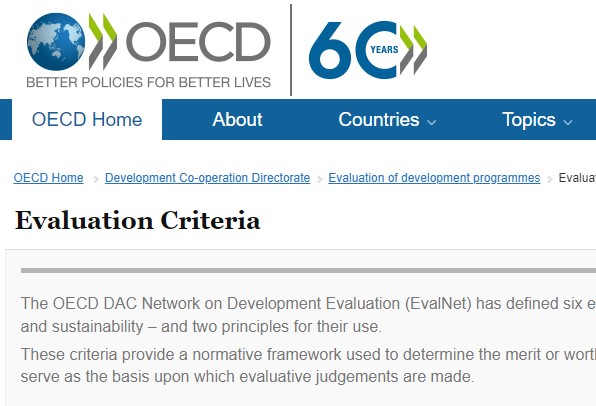
Evaluative criteria provide an overarching normative framework for intervention assessment; and play a vital role in guiding the evaluation questions (UNEG, 2011). However, given the vast thematic areas development projects work across, a standardized criteriai that work across different ‘evaluands’ (Mathison, 2005) – i.e. different objects of evaluation – is highly useful. Towards this end, the Organization for Economic Cooperation and Development (OECD) – a unique international forum of international development aid organizations – developed, the DAC criteria in 1991, to evaluate how effectively their development co-operation efforts and policies were working towards the achievement of the 2030 Agenda for Sustainable Development.
While used and accepted widely, given the limitations of the criteria; there was a felt need for the criteria to be revised (especially, following the 2015 agreement of the 2030 Agenda for Sustainable Development.) (OECD, 2019). Pursued by the DAC Network on Development Evaluation (Eval Net), revisions were made to expand the criteria, and were then adopted by the OECD-DAC in 2019. The DAC criteria are used widely by several multi-lateral organizations such as the United Nations, and governments to benchmark their policies and programs (UNEG, 2011).
The updated framework consist of six evaluation criteria, defined by OECD DAC as follows (OECD, n.d.):
Relevance: “The extent to which the intervention objectives and design respond to beneficiaries, global, country, and partner/institution needs, policies, and priorities, and continue to do so if circumstances change.”
Coherence: “The compatibility of the intervention with other interventions in a country, sector or institution.”
Effectiveness: “The extent to which the intervention achieved, or is expected to achieve, its objectives, and its results, including any differential results across groups.”
Efficiency: “The extent to which the intervention delivers, or is likely to deliver, results in an economic and timely way.”
Impact: “The extent to which the intervention has generated or is expected to generate significant positive or negative, intended or unintended, higher-level effects.”
Sustainability: The extent to which the net benefits of the intervention continue or are likely to continue.

Source: (“Applying Evaluation Criteria Thoughtfully,” 2021)
Also, OECD DAC gives two principles that guide practitioners using these criteria. The website list these principles as follows (OECD, n.d.):
The criteria should be applied ‘thoughtfully’ – contextualized to the evaluation, the nature of the intervention, and the stakeholders involved – to support ‘high quality and useful evaluation’. The ‘evaluation questions’ and ‘what one intends to do with the answers’, should ‘inform how the criteria are interpreted and analyzed’.
List of recommended resources:
For a broad overview

Blog Post: Evaluation Criteria by OECD
The OECD webpage defines the six evaluation criteria and provides the principles for their use.

This document describes the revised Evaluation Criteria, their definitions and use, and well as their principles of usage. A shorter version of the same is available on the following link: Better Criteria for Better Evaluation: Revised and updated evaluation criteria

This video is prepared by Neerman, and gives a simple overview of OECD DAC criteria. For a written overview of the same, read this Blog post , guiding practitioners on asking the right evaluation questions through the use of the OECD DAC Criteria.

For in depth understanding

Published by the UN Evaluation Group (UNEG), this webinar gives an overview of consultation process to update old OECD DAC criteria and discusses the motivation behind these changes and their significance. Furthermore, it has a detailed discussion on using new OECD DAC criteria and critical principles for its application.

Published by ALNAP, this document provides practical support on using he OECD Development Assistance Committee (OECD/DAC) criteria in evaluation of humanitarian action. It provides brief guidelines for good practice in methods for the evaluation of humanitarian action.
Case Study

Developed by DMEO, NITI Aayog, this case study demonstrates the use of OECD criteria to evaluate the performance of Women and Child Development sector in India.

Developed by DMEO, NITI Aayog, this case study demonstrates use of OECD criteria to evaluate job and skilling schemes like Pradhan Mantri Kaushal Vikas Yojana (PMKVY) in India .

Presented by Megan Kennedy (Senior Policy Analyst OECD) and Rachel Bedouin (FAO Evaluation Office), this webinar discusses the new OECD DAC criteria, the rationale for revisions made to the criteria, its pros and cons, and its’ relevance in the present context. It illustrates this with a case example of the capacity development of the irrigation department in Afghanistan.
Further Reading

Developed by Deval – German Institute for Development Evaluations, this document discusses the need for reforming the OECD DAC in the light of the 2030 UN Agenda, in increasing its operational usefulness, as well as streamlining the differences between the different criterion.

Written by Thomas Chianca, this paper provides a critical review of the old OECD DAC criteria. It proposes significant recommendations for changes, including the revision of definitions, the addition of key missing criteria, and discussions about the level of importance of the criteria

Developed by World Bank, this document gives a detailed account of stakeholder consultation regarding OECD DAC criteria highlighting changes in evaluation criteria
References:
Better Criteria for Better Evaluation-Revised Evaluation Criteria Definitions and Principles for Use. (2019). OECD. https://www.oecd.org/dac/evaluation/revised-evaluation-criteria-dec-2019.pdf
Better Criteria for Better Evaluation-Revised Evaluation Criteria Definitions and Principles for Use. (2019). OECD. https://www.oecd.org/dac/evaluation/revised-evaluation-criteria-dec-2019.pdf
Evaluation Criteria. (n.d.). OECD. Retrieved December 16, 2021, from https://www.oecd.org/dac/evaluation/daccriteriaforevaluatingdevelopmentassistance.htm
Integrating Human Rights and Gender Equality in Evaluation-Towards UNEG Guidance Guidance Document. (2011). United Nations Evaluation Group. http://www.uneval.org/document/detail/980 Mathison, S. (2005). Encyclopedia of evaluation (Vols. 1-0). Thousand Oaks, CA: Sage Publications, Inc. doi: 10.4135/9781412950558
OECD DAC. (2018). OECD DAC Evaluation Criteria: Summary of Consultation Responses. https://ieg.worldbankgroup.org/sites/default/files/Data/DACCriteria/ConsultationReport_EvaluationCriteria.pdf
